Flat silk is used hand embroidery in a variety of techniques. I’ve recently been on a “flat silk” kick, as you may know from my previous comparison of flat silks. I’ve added the flat silk from the Japanese Embroidery Center into the comparison now, and have some photos to share with you.
These photos of flat silk don’t really do the different silks justice. You have work with them, feel them, play around with them, to really get the sense of which ones you like best. The thoughts here are just my opinions, after playing around with the different silks.
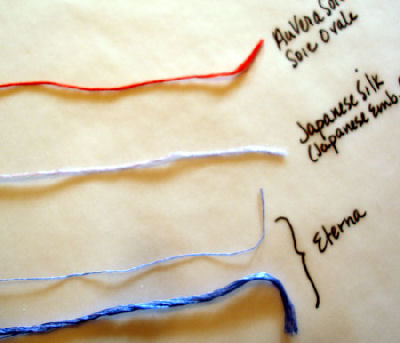
Unfortunately, I ordered rather pale colors from the Japanese Embroidery Center, so they don’t show up as well in the photo. What we have here are three types of flat silk: Au Ver a Soie Soie Ovale, Japanese Flat Silk, and Eterna (which is a Chinese flat silk which comes in groups of 12 strands).
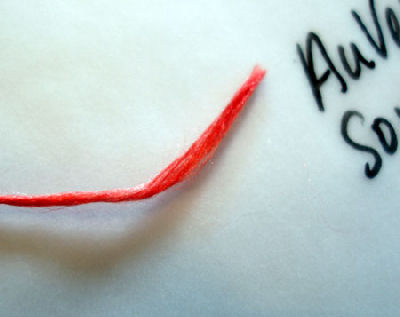
This is the Soie Ovale up close again. You can see the individual filaments of silk (I believe they are called “suga”) which make up the full strand.
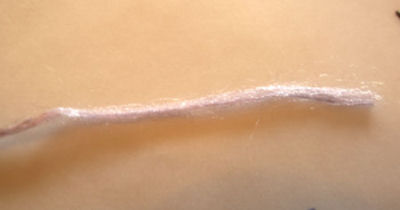
This is the Japanese silk up close. It looks fuzzier in the photo than it actually is. You can see farther down the strand, away from the end, that it is not as fuzzy as it looks. The “fuzzy” end comes from handling. Again, you can see the individual very fine suga. Each strand of Japanese silk is made up of 12 suga.
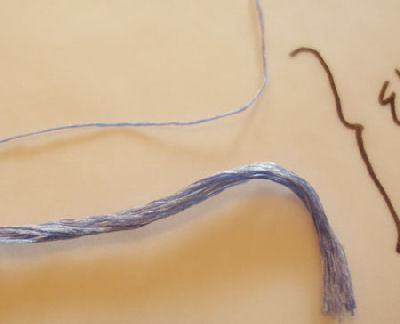
Here, you can see the stranded silk from Eterna, which I purchase from Yodamo. Each “bundle” has 12 strands, not to be confused with filaments or suga, which are much finer. Each strand of the Eterna stranded silk would be made up of so many filaments. It takes approximately 2 strands of Eterna to equal the thickness of one strand of typical DMC 6-stranded embroidery floss. So – you guessed it – one strand of Eterna is very fine, and can be used for fine detail work. Believe it or not, the strand can be further split for even finer work.
Filament silk, by the way, is the silk pulled straight from the cacoon in long strands – as opposed to spun silk, which is all the left-over spun into the thread or floss. Filament is generally stronger silk with a higher lustre.
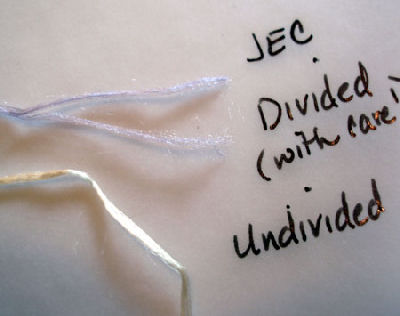
Here, I’ve divided the Japanese silk (the top one is divided) and laid it next to the undivided Japanese silk. You can divide this filament silk carefully. It will go back together in a smooth strand when you run it through your fingers (I suggest Au Ver a Soie hand cream when you’re doing this kind of work – it reduces the friction on the thread and the snags…) Separating the filaments gives you an even finer thread to work with.
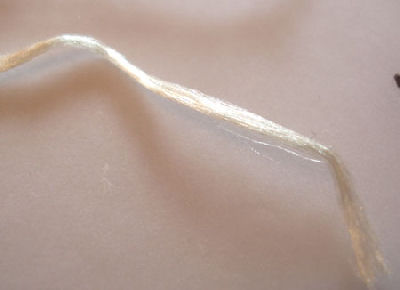
Another close-up on the Japanese silk….
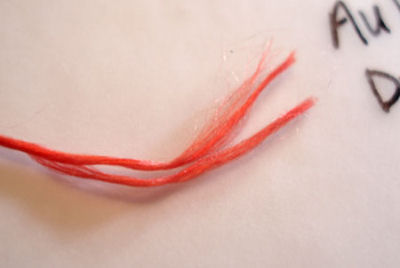
Here’s the Soie Ovale separated carefully. Again, same thing – after you’ve separated it, running it through your fingers puts it together again for working.
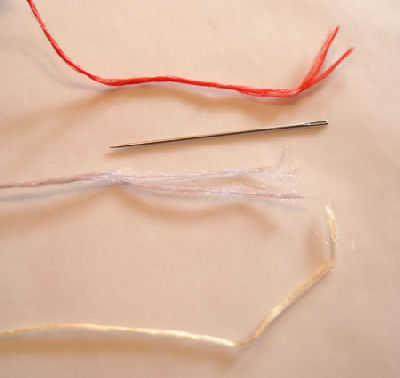
Just to give you some perspective, I threw in a #10 embroidery needle, so you can get the relative size of the threads.
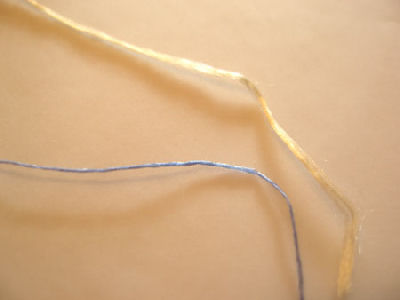
And here’s one strand of Eterna Silk and the Japanese silk side-by-side.
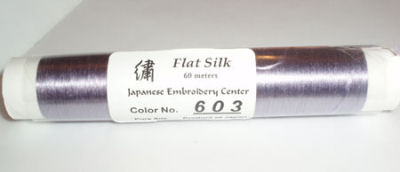
The Japanese silk comes in 60-meter spools from the Japanese Embroidery Center, at $7.00 for 60 meters. Shipping is reasonable, but somewhat slow. They guarantee shipping it out within five days of placing the order. Sometimes their website is quirky and doesn’t seem to work, but with persistence, you shouldn’t have a problem. You can also call and place an order. All the information is on their site.
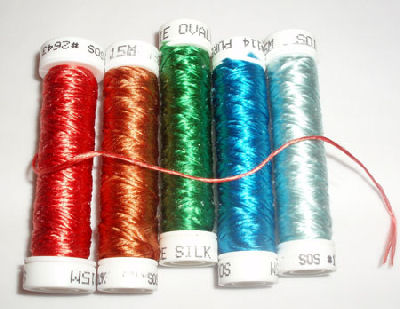
The Soie Ovale comes in 15 meter spools for about $3.35. In other words, for approximately the same price as the Japanese silk, you get 40 meters less! I order Soie Ovale from Needle in a Haystack, which is the only place that seems to carry a ready selection of it. If she’s out of stock, she’s quick to place the order and get the product to you. Shipping is very reasonable, and the turn-around between order and arrival is minimal.
To sum up, these are my observations on the above silks.
- Best quality of the three silks overall – it’s a bit thicker (more filaments) and the thread seems to have more “body” to it.
- Most expensive overall – which is a drawback!
- Nice colors, but low range of colors – only 59 available
- No color card, but the colors match the Soie d’Alger color chart, so you can cross-reference
- Next best quality of the three silks overall – it’s not as thick as the Soie Ovale, has less body, fewer filaments
- However, it has a better color range – about 258 colors – and a great color card for selection.
- Considerably less expensive when compared to the Soie Ovale
- And nice to work with, like the Soie Ovale
- Update: Eterna Silk is no longer available – the business apparently has closed.
- Per strand, not as thick as the previous two silks, and overall, does not seem as “high quality” – but it’s ok – I do like it. It is not as “flat” as the other two, either.
- The strands can be doubled, requiring the use of a laying tool to get a really smooth effect
- 5 meter skeins, with 12 strands per skein, are $.95. $7.00 will get you about 35 meters of 12 strands each, and about 3 or 4 strands equal the thickness of the Japanese silk, so, in essence, for the same price as the Japanese flat silk, you’re getting about 105 meters of silk (if my math is correct!) So this is the least expensive option.
- An extensive color range – with 545 colors available.
- Printed color chart is available, but I found it inadequate in choosing colors.
So there you have it! I think, weighing quality, availability, and affordability, I’ll be playing around more with the Japanese Silk.
If you have any insights into other silks, or questions about any silks in particular – or any recommendations, etc. – feel free to share!! I’m all ears!
I’m also willing to try out various silks, as long as the expense isn’t too much, and write up comparisons, so if there’s anything you want to hear about in particular, let me know!







Hello Mary
Thanks so much for your helpful comparisons. I have been giving this matter much thought lately as I am pretty certain that I will be using silk as the mainstay of my embroidery from now on.
I have some Japanese silk and also the full range of Kreinik soie platte, which I believe is same as the soie ovale. I am actually leaning towards the Piper silk. It is finer than the two mentioned above, but I’d rather double or triple my thread instead of splitting it. It comes in more colors than the soie ovale, but fewer than the japanese silk. It is not as expensive as the JEC silk either, and the tubes are smaller and easier to store.
Piper also makes their silk into various twists and folds of silk, so I can easily add some texture to my work, too. Not sure what is meant by “folds” but I think it is a very loose twist. The only downside I can see is the long shipping time from England.
Marilyn
Hi, Marilyn – Thanks again for the helpful comment! I’m going to invest in some of the Piper’s silk, so eventually, I’ll line that up next to the others. I agree – I’d rather work with more strands than split strands!
Mary, I have some duplicate colors of pipers if you would like I can drop a couple in the mail to you. Piper’s has about a 3 week backlog right now. In addition, they are currently on vacation. Let me know your address and I will give you my extras.
Marilyn
Hi, Marilyn! That’s so very NICE of you! I’d love to see some of the piper’s silk! I did place an order today, but it says to expect up to a month for delivery (and that’s within the UK). If you want to e-mail me at mary[at]needlenthread.com, I’ll send along my address. That’s the regular e-mail format with the @ symbol (avoiding extra spam…) Thanks heaps!
Howdy! I’m intrigued by your comparisons – one question that I’m still wondering about, is how twisted these “flat” silks are. I carefully measured a length of Kreinik Soie Platte, and found that it had 1 twist every .75 inches – not much, but it does make a difference. I’m trying to replicate similar embroidery silk by hand, and lightly twisting makes it easier to process.
Hi, Michael – you’re right, there is a “slight” twist to most of them, except the Japanese Embroidery Center silk. It comes off the spool perfectly flat. The Kreinik Soie Platte is the same, I think, as the Soie Ovale by Au Ver a Soie – at least, they used to share the same name. When you unreel it from the spool, you do find that there is a very slight twist in the whole group of tiny strands, but it seems to me to be more of a “bunching” thing, if that makes any sense. I don’t think the silk is actually twisted at all. At least, the strands don’t twist together, like a proper twisted thread does. With the Chinese silk (Eterna, in this case), the whole group of filaments that make up the divisible strand is twisted (again, only slightly). When you separate them, they are more or less flat. I use a laying tool with flat silks, which keeps them REALLY flat. The Piper’s Silk (or the True Embroideries Sleave Silk – TESS) comes off the real completely flat as well. Actually, you can take any of them and twist them together to make a twisted cord or even twisted silk to embroider with. I can’t measure all the silks above for a twist right now – I’ve used up my supply of most of them and am working with twisted threads lately. The only flat silk I have is the JEC stuff, and it is flat, with no twist at all. I hope that helps!
I was surprised to find when I was researching how silk threads are created, that “a slack twist” is usually recommended even for flat silks – it keeps the filaments from snagging and making loops during the processing. I have made some flat silks where I have actually stroked them along my thumbnail after degumming and dyeing, to make them *truly* flat – and in some cases it really does make a difference. In a lot of cases, it’s hard to tell if there’s one twist every inch or so, because the stitches aren’t that long.
The way I measured the Soie Platte (which I’m pretty sure is the same as Soie Ovale) was to put a flat fold of tape on one end so that it had to flip over visibly to untwist itself, and tape the other end to the table, and then run a pin through the center of the length. That showed up any barely-there twist, and I got 9 flips out of a six-inch length.
If you’d be willing to measure twist in a couple of different kinds, or if I could swap you something for just a foot or so of the different kinds (color is irrelevant), I’d be delighted!
Methinks I shall e-mail you… I can always dig through orts for leftovers!
MC
Hello Mary, the comparison of the different kinds of silk was such a great help to me when I was looking into what kind of silk I wanted to get. I am pretty sure that I want to buy the flat silk from the Japanese Embriodery Center, and I wanted to get a royal blue color. However, there are so many blues on their site and I don’t exactly have the extra cash to invest in their awesome sample card set at this time. I was wondering since you purchased the color charts, would you mind helping me out and check which color number is the royal blue color.
I’m trying to get a blue flat silk that is closest to this royal blue flower necklace that I’ve made: http://www.etsy.com/view_listing.php?listing_id=9854263
Any help you can provide will be greatly appreciated. You can also email me at itreallyaddssomething@yahoo.com
I have read your comparison with great interest — I've been trying out different silks myself (filament & spun, stranded & indivisible, flat & twisted) and have found that I prefer the flat silks. Soie Ovale is lovely to work with, but what a shame about the limited range of shades!
I use Eterena for "everyday" silk stitching, but would love to try out the JEC silks; however, like Ann (above), I haven't really got the resources to spend $60 on a shade card just to order 3 or 4 spools to try out! Would you happen to know if there is anywhere on the web where they show the colours, rather than just the number and name of the silks?
Also, have you tried their "Original flat Silk" (which is available in only 8 colours, I think), and if so, is it very different from their regular flat silk?
Hi, Ilke –
Unfortunately, I haven’t come across any color charts for the JE flat silk online. You could probably do as I did at first. I picked a color name of a color I like, and then ordered a few shades in that color to test out.
I don’t know if the original flat silk is different or not. I suppose it must be somewhat different, or they would have incorporated it into the range of colors of the regular flat silk.
I, too, like the soie ovale – it has nice “body” and is less flighty to stitch with!
Don’t hesitate to contact me if you have any other questions!
MC
Hi Mary, I have since bought 4 beautiful greens (Sea Foam) from a JEC accredited tutor in England. It is gorgeous to work with and one day I will get that shade card!
I also got some of Pipers 90 Silk Floss, which has a good flat look even when you have to combine 3 or 4 threads to get the required thickness — and at £1 for an 80-metre reel it is quite good value, plus it comes in a good range of shades (almost as many as JEC). Have you written about Pipers as well? If so I seem to have missed it. I also tried House of Embroidery Fine Silk, which is quite nice to work with but only comes in shaded/variegated colours.
Thanks again for your helpful comparisons!
Hi, Ilke –
I think I've written about TESS (which is Helen Stevens's silk, but it's the same as Pipers). In fact, I was sent some Pipers silk once upon a time, too, so I probably did write about it at one point. I don't think I ever included it in the comparison articles, though.
I've been hoping to write up a few more thread comparison articles – not just on silk – so maybe I can work that one in, in the future!
Thanks for the suggestion!
Best regards,
MC
Hello Mary,
some time ago I did a project in six flat silks (Soie Ovale, JEC, Eterna, Pipers, House of Embroidery and the discontinued Pearsall's Filofloss) to compare them — it's cross stitch, not free-style embroidery, but I was wondering whether you'd like a picture and the notes I made? If so I could email them to you.
Hi, Ilke! I'd love to see it! That would be really neat. I haven't actually worked a project with a variety of flat silks for comparison – but it's a great idea! I'd love to see your photos!
MC
Hi Mary — not sure how to email you? Let me know how I can get the pictures and report to you and I'll send them.
HI, Ilke – you can reach me at mary (at) needlenthread (dot) com – you can also use the "contact us" form above to drop me a line which I would then reply to (unless you happen to use an AOL address, as I'm unable to reply to AOL addresses, though I can receive e-mails from them.)
Thanks!
MC
Report and picture are on their way!
Find yourself a Japanese Silk Embroidery teacher and you will learn the most amazing ways to use the flat silk including how to split it correctly and how to twist it to perfection
merci pour vos explications je debute en broderie et suis un peu ennuyée dans le choix de mes fils a broder.En france nous avons très peu de fils de soie.
Thank you for the very nice review of my silk 🙂
Yes, I am the maker of EternaSilk™ and each color is dyed by me, right here in the USA. I am especially proud of my variegated over dyed colors. The ‘flat’ silk is not completely equivalent to the Japanese flat silk. Different moth, different technique in reeling. However, my intent was to create an affordable alternative to cotton, and in that I believe I have succeeded 🙂
The ‘flat’ silk is indeed an amalgamation of ‘silks’ (the name for each individual cocoon ‘strand’ in Chinese). In my case, based upon my own preference, I decided to have them gently ‘rolled’ together. In that way, I can more easily wind and label the Strands of silk, without having the added expense (not to mention the petrochemical waste) of winding the Strands on plastic reels.
Yes, I do all of that dyeing, winding, cutting and labeling right here, on my own, making my own labels also 🙂 It’s a bit difficult keeping over 3,000 shades/thread types in stock all day, every day, but I do it because I love it, and hope that I can share as much of it as I can before my days are done.
Regarding hand creams – we used to use “Udder cream” available from all good chemists – it really is meant for sore cows but gives a very smooth not greasy feel to hands. First came across it when lace-making with 210 cotton threads. T’other thing is if you dry your hands in oatmeal just before working the cotton or silk your hands again are smoothed!! Couple of suggestions from “old England” that go back a few years…
Hello Mary,
When I lived in Japan several years ago, I enrolled in a silk embroidery course. We used flat silk and twisted it to specifications for different parts of each design. The length of silk is secured to a peg in the frame. The silk is carefully separated into two parts, placing one part between the lips to hold it taut. The second part is rolled between your palms to the desired twist, then the two parts are switched . When they are finished, they will twist together, and the resulting thread is a delight to work with, and shows off the full sheen and beauty of the silk. The colors seem endless, and I avidly collected glorious spools. Also, at times the silk is used as it comes from the tube, and used this way is usually couched, sometimes with so few filaments it is not noticeable.
wow lots of helpful information without the expense of having purchase all the different silks! I really appreciate this
Thank you so much for this comparison! I stumbled across it while searching for a source for flat silk floss to use in making fly trim for a 17th century gown. Soie Ovale was so hard to find with varying stock. I am going to try with Japanese flat silk instead!